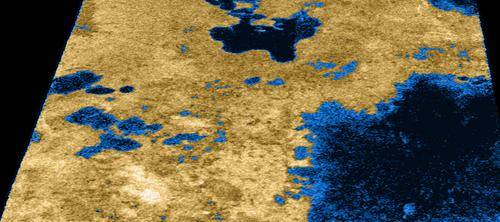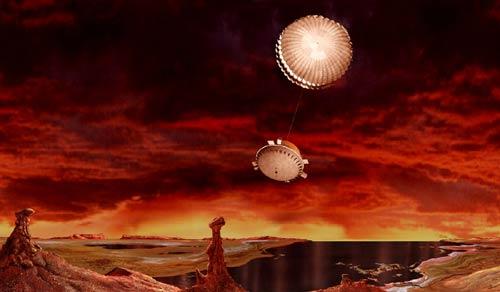
Image credit: NASA/JPL/USGS
Radar data, obtained during a recent Cassini flyby of Titan, Saturn's
largest moon, strongly indicate the presence of liquid methane lakes on Titan. This
is the first discovery of lakes on another planetary body.
Titan is the second largest moon in the Solar System. It is also the only
moon known to have a substantial atmosphere. Titan's thick and smoggy
atmosphere almost completely obscures the moon's surface.
The existence of oceans, or lakes on Titan was predicted over 20 years ago,
but Titan's hazy atmosphere hindered direct observation. To study Titan's
surface, scientists apply radar techniques, and observe the moon in infrared
light. These radiations are capable of penetrating the hazes, and reveal
Titan's surface features.

An artist's impression of Titan's surface
This illustration shows the space probe Huygens landing on Titan's surface,
featuring large lakes filled with liquid hydrocarbons.
Credit: NASA-JPL
It has not been possible to confirm the existence of Titan's lakes before
the Cassini flyby of 22 July 2006. Radar imaging data obtained during the flyby
provide convincing evidence for large bodies of liquid.
The image above shows part of what Cassini detected. In this image, the
colors are not a representation of what the human eye can see. They code the
brightness of the radar waves reflected off the surface of Titan. Radar-dark
features are coded blue, and radar-bright regions are represented in tan.
The dark features are interpreted as lakes because they are morphologically
similar to terrestrial lakes, and liquid surfaces poorly reflect radar waves.
More than 75 lakes were detected, ranging in size from about 1.5 km to over 70 km across. Some of the lakes are partially filled, indicating a possible evaporation process.
Some of the lakes resemble terrestrial lakes confined within impact basins
(e.g., Clearwater Lakes, Canada), or volcanic caldera (e.g., Crater Lake, USA). Bright patches in some lakes may be interpreted as islands.
The discovery of these lakes is evidence that Titan, like Earth, has an
active hydrological cycle, but with liquid methane, not water. In this cycle,
lakes are filled due to methane rainfall, or intersect with a subsurface layer
saturated with liquid methane.
Further reading
Titan Has Liquid Lakes, Scientists Report in Nature
http://www.jpl.nasa.gov/news/features.cfm?feature=1258
Cassini Finds Lakes on Titan's Arctic Region
http://www.jpl.nasa.gov/news/news.cfm?release=2006-097
Aymen Mohamed Ibrahem
Senior Astronomy Specialist